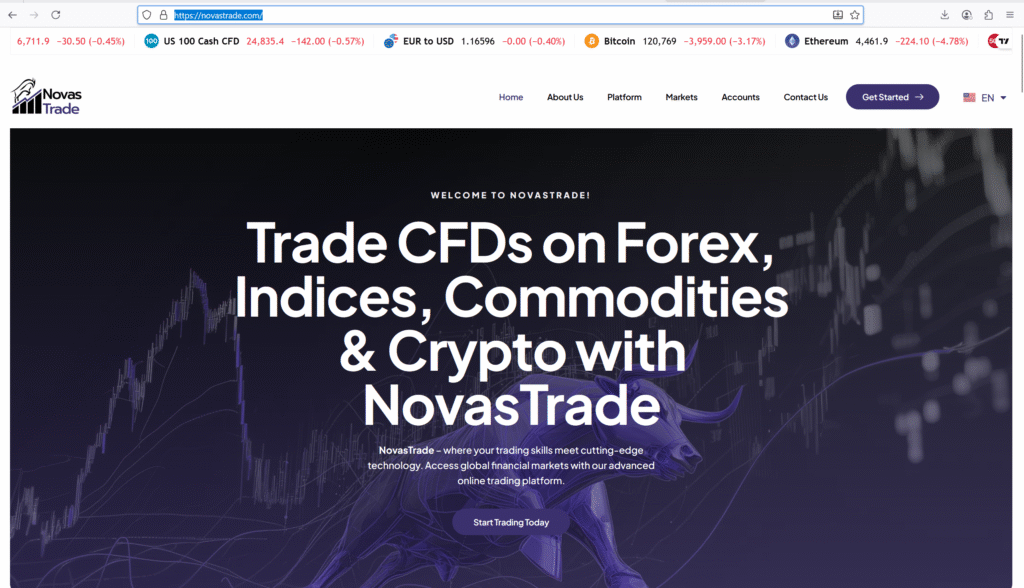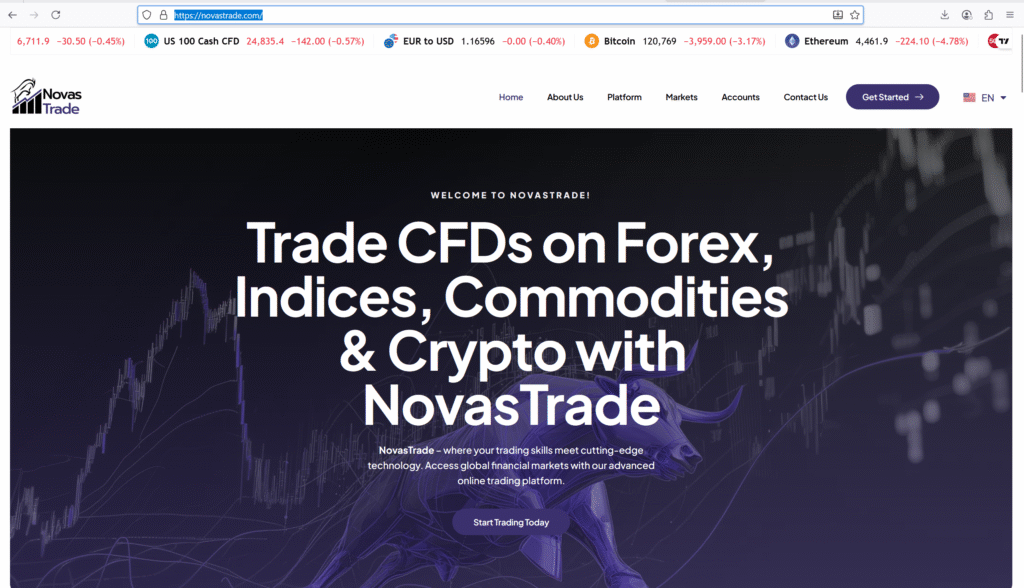In a market crowded with glossy “next-gen” trading platforms, NovasTrade presents the familiar playbook: frictionless onboarding, tight spreads, high leverage, pro-grade tools, and a promise to “upgrade” your results. That is the classic Element 1 appeal: sell an enhancement, imply superior outcomes, and bury the tradeoffs. Look past the marketing, though, and a very different picture emerges. Below are seven ruthless red flags that show why NovasTrade should be treated as high risk and why capital protection not performance chasing ought to be your first priority.

1) Authorisation Mirage vs. Real Oversight
Legitimate brokers lead with verifiable regulation: license numbers, regulator lookups, and a traceable corporate entity. NovasTrade has drawn formal warnings from major regulators stating the firm is not authorised to offer financial services locally. When a platform is flagged by top-tier authorities, it undercuts the entire “safe upgrade” narrative; there is no meaningful investor protection, no prudential supervision, and no binding dispute resolution. Without a regulator standing behind client funds and conduct rules, all the shiny features amount to marketing, not safeguards
2) International Risk Echoes (Cross-Border Alerts)
It’s not just a single jurisdiction raising its hand. Cross-border alerts escalate the risk profile because unlicensed platforms commonly “jurisdiction-hop,” shopping for laxer environments while still soliciting foreign clients. When multiple authorities and international networks log the same brand as unauthorised, that pattern strongly suggests a systemic compliance gap, not a clerical oversight. Practically, it means you could be wiring funds into a structure designed to outrun accountability.
3) The “Upgrade” Hook: Spreads, Leverage, and Bonuses
NovasTrade’s proposition leans on performance language spreads “from zero,” lightning execution, high-octane leverage, and incentives. In isolation, none of these features is proof of wrongdoing; together, in an unregulated context, they’re a red-flag cluster. Zero-ish spreads are often offset by commissions or opaque mark-ups. Ultra-high leverage magnifies losses faster than most retail traders can manage. And deposit bonuses routinely hide withdrawal-blocking clauses in the fine print. This is the Element 1 trap: sell an upgrade that feels empowering; reveal the cost only after the money moves.
4) Contested Public Reputation (Signals vs. Noise)
Surface-level star ratings can mislead. What matters is pattern: reports of stalled withdrawals, poor responses to complaints, or vague terms are far more telling than a few five-star blurbs. Public review hubs note mixed to negative sentiment around transparency and service, alongside a banner that the brand has attracted regulatory attention. A platform that appears “average” while concurrently sitting on warning lists should be treated like a foggy runway—approach only with extreme caution, if at all.
5) Third-Party Risk Screens Ring the Alarm
Independent risk checkers that aggregate technical, reputational, and ownership signals frequently assign very low trust scores to the brand’s domain. These tools aren’t perfect, but they’re useful barometers—especially when their outputs corroborate official regulatory warnings. A convergence of low trust scores with “unauthorised firm” notices is not bad luck; it’s usually a coherent risk story pointing in the same direction.
6) The Playbook After You Deposit
Victims of unregulated brokers around the world describe the same sequence: brisk onboarding, dashboard profits that look great on-screen, escalating nudges to deposit more, and then the stall when you try to withdraw. The reasons vary—“AML review,” “tax pre-payment,” “release fee,” “security hold”—but the effect is the same: your funds don’t come back on normal terms. The platform might even dangle higher-tier “VIP” status if you add capital, converting sunk-cost bias into a funnel. If your money only “exists” inside the broker’s interface and never in your bank account, you haven’t profited—you’ve been parked.
7) Structural Asymmetry: They Control the Game
When there’s no regulator and no independent audit, the broker controls pricing, execution, slippage, and account status. That asymmetry lets a bad actor widen spreads at will, re-quote in volatility, freeze accounts during “reviews,” or invent administrative hurdles at payout time. In a fair venue, audited controls and client-asset rules limit those behaviors. In an unlicensed venue, you’re operating in a black box where the house writes and enforces the rules.
Practical Due-Diligence Steps (If You’re Already In)
1. Freeze further deposits immediately. Don’t throw good money after bad.
2. Preserve evidence. Export account statements, balances, trade logs, emails, chat transcripts, and any “fee” requests.
3. Attempt a small withdrawal. Document every step, response, and delay.
4. Report quickly. File complaints with your local financial authority and consumer-protection agencies; cross-reference international alerts to strengthen your case.
5. Engage specialised investigators. Firms that combine crypto-tracing, OSINT, and regulatory coordination can significantly improve your odds of recovery when funds have been moved across wallets or processors.
Conclusion
NovasTrade is packaged like many of today’s “upgrade” brokers: the promise is speed, precision, and access; the reality is oversight vacuum. When top regulators publish that a firm is not authorised, they’re not commenting on website aesthetics they’re telling you there is no enforceable safety net. That single fact reframes every other claim the platform makes. Tight spreads? High leverage? VIP tiers? Without regulation, those are not features; they’re lures.
In healthy markets, a broker earns trust by submitting to constraints segregating client funds, undergoing regular audits, and answering to a supervisor with teeth. The constraints are the point. They limit how much a broker can do to you. By contrast, an unregulated setup asks you to take every promise on faith while granting itself complete operational discretion over tools you cannot see: pricing engines, order routing, internal matching, spread adjustments, and withdrawal gates. That’s not a partnership; it’s a control relationship tilted against the client.
The mixed review footprint should not comfort you. Average star counts can mask severe risks when the sample is small, skewed, or peppered with generic praise. What you cannot dismiss are official warnings and independent risk scores that converge on the same conclusion: the trust baseline is low. In money management, a low baseline is reason enough to disengage.
If you are already entangled, your priorities are time and documentation. The longer funds remain on a platform flagged by authorities, the greater the chance of layering (rapid, multi-hop movement across wallets or merchants) that complicates recovery. Collate every scrap of evidence—from initial sales pitches to KYC confirmations and fee requests and initiate formal complaints swiftly. That paper trail matters: it can unlock cooperation from exchanges, payment processors, and law enforcement, especially when your report anchors to public regulator alerts.
For those still deciding, the decision matrix is simple. Ask: Is there a straightforward, regulator-verified license path? Is there a long, clean history of timely withdrawals? Are client assets protected by law, not by marketing? If the answers are fuzzy, say no. You don’t need the “perfect” broker; you need a bounded-risk venue with checks, transparency, and recourse.
NovasTrade’s story, in short, is not about innovation; it’s about asymmetry between what you are promised and what you can enforce. In the absence of real oversight, the safest upgrade you can make is to your own process: verify first, deposit later, and never let marketing language substitute for regulatory reality



